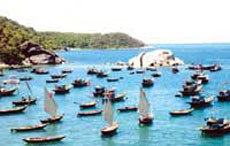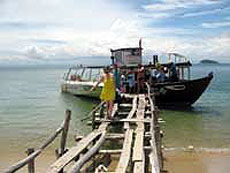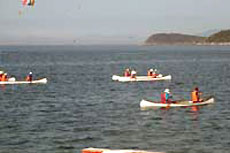The most beautiful postcards and landscape paintings or photo-graphs come to life with just one glimpse of Cham Island (commonly known in Vietnamese as Cu Lao Cham).
 |
|
Fishing for compliments: Boats at Cu Lao Cham. |
Strung along in the shape of mermaid, the eight islets that form the island are lush green paradises fringed by pristine white-sand beaches and blue waters.
Individually, they are known as Lao (Pear), Dai (Long), La (Leaf), Kho Me (Large Rocky Islet), Kho Con (Small Rocky Islet), Tai (Ear), Mo (Tomb) and Ong (Grandfather). Together, they present 40,000ha of extraordinary beauty and vast ecological diversity.
Cham Island also presents a pristine lifestyle with most residents living on fishing off the Lang and Huong beaches. A small portion is engaged in agriculture, making handicrafts or hiring out their labour.
The island is situated 20km off the coast of central Quang Nam Province’s Hoi An Town.
The biggest islet, Hon Ong, has a population of 3,000, mostly fishermen.
Cham Island is home to 1,500ha of tropical forest and 6,700ha of sea featuring a wide range of marine fauna and flora, which include many endangered species. Two of them, salangane (swallows) and the long-tailed monkey, are listed in the Viet Nam Red Book of endangered species.
Lecturer Hans Dilev of Denmark’s Aarhus University says the Cham Island is one of the few places in Viet Nam that still possesses a large area of vegetation and a wide range of rare and endangered animals.
Its crystal clear waters are also a great place for tourists to go scuba diving or take a ride a glass bottomed boat and partake of the magical sights beneath the water.
Huong and Ong beaches are particularly popular because the waves here are smooth and gentle.
 |
|
Watch your step: Tourists enjoy travelling by boat in the balmy waters around the town of Hoi An. |
Despite its proximity to the world famous heritage site of Hoi An Town, the Cham Island offers unspoilt vistas and glimpses into a way of life that has altered little over the last several decades.
A boat from Hoi An is the only way to access the islets. Visitors can breathe pure air, enjoy the limpid sunlight of the central region and watch flying fish skim over the surface of the water while taking a cruise in a wood boat offered by local tourism companies.
A boat trip takes about an hour and a half, and a speedboat finishes it in just 25 minutes.
An ancient-looking wooden pier welcomes visitors to the Cham Island.
One of the first things a visitor can do is to take a stroll along the beach and see rocks piled up in special shapes very close to the forest.
Small tea shops with thatch-leaved roofs on the beaches of the Cham Island are renowned for a special kind of drinking water which has a dark yellow colour like eugenia tea.
"We boil ten kinds of leaves which are picked in the forest. Residents of the island rarely get sick because they drink this gentle and nourishing water," said the owner of the tea shop.
Islanders are learning quickly about responding to tourist needs and the hospitality industry is developing rapidly. Visitors can easily go on sightseeing tours by boats around the islets, hire fishing and diving gear, and have special dishes at reasonable prices.
 |
|
Tranquil waters: Tourists enjoy kayaking. |
The Cham Island never fails to win kudos for its seafood and delicacies like octopus, lobsters, fish fin, abalone, bird’s nest, shellfish, cua da (rock crab) and sea cucumbers.
The signature dish of the island, though, is steamed or boiled vegetables served with mam nem, a type of fish sauce. More than ten kinds of vegetables, each its distinct flavour - buttery, bitter, acrid and tart - combine superbly with the hot, salty and sweet dipping sauce.
Tasty rock crabs
Another famous product and dish of the island is the rock crab. These creatures live in springs and small caves in the mountain. They play an important role in the local inhabitants’ livelihood. Almost all islanders can catch rock crab, which is tastier than those got from the sea.
Rock crabs are kept for sale in iron baskets in front of every house, together with dried and spiced fish, or squid.
Stories about the life of fishermen are another highlight. "I love to go fishing in September and November. A shark catch is worth days of fishing or cuttlefish," says veteran fisherman Dinh Day who owns two fishing boats. For a price, tourists accompany local fisherman as they go shark fishing.
"Shark fishing is very dangerous but its fin is nutritious and expensive. Fishermen have to be brave, smart and combine forces to not get eaten by them," says Day.
Day says he usually catches sharks that weigh about 70kg, but there are times when he lands one that is over 200kg. Traders will pay VND8 million (US$420) per kilogram for the big fish.
Visitors can also observe swallow nests that are perched precariously among the island’s towering cliffs, or visit a temple built to honour the ancients who first discovered the birds’ nests.
According to archaeologists, Cham Island was first settled in about 3,000 years ago, and its inhabitants established business contacts with external countries some 1,000 years ago. A quantity of ancient artefacts of the Sa Huynh, Champa and Viet cultures can be found here.
Cham Island has been added to UNESCO’s World Network of Biosphere Reserves, areas that focus on sustainable development and environmental protection.
Viet Nam currently has eight UNESCO-recognised biosphere reserves. Others are Can Gio Mangrove near HCM City, the Cat Ba Island in the northern port city of Hai Phong, Cat Tien National Park north of HCM City, the Kien Giang Biosphere Reserve in the southern province of Kien Giang, the Red River Delta Biosphere Reserve near Ha Noi, the Western Nghe An Biosphere Reserve and Cape Ca Mau.